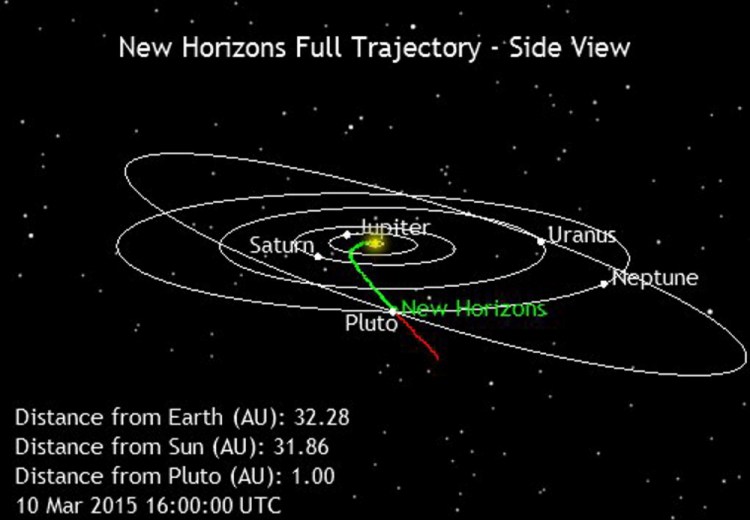If you get up really early the morning of July 14 this summer and look toward the southwesterly horizon, you’ll be looking in the general direction of the center of the Milky Way galaxy. Among the wash of stars there will be dwarf planet Pluto, which you won’t see because it’s so small, dim and far away.
At that moment, the New Horizons spacecraft will be just a few hours from its closest approach to Pluto, which it’s been bulleting toward for the past nine years. Pluto sets about 4:45 (our time) that morning, but about 11:45, New Horizons will buzz within about 6,200 miles of it. Fourteen minutes later it will pass within about 16,800 miles of Charon, Pluto’s large moon.
New Horizons is about the size of my Toyota and weighs about half a ton. When it rushes past Pluto, its instruments will be gobbling up temperature, atmospheric and particle information. Its telescopic camera will be taking photos that will be the most detailed pictures by far ever taken of Pluto, Charon and the other four much smaller moons, because the whole system is not quite 3 billion miles (about 31.9 astronomical units) away — too far and too small for even the Hubble Space Telescope to get images any better than murky.
The photos will show the rock and ice of Pluto, the nitrogen snow on its surface, its possible mountain ranges and chasms. The planetary astronomers think there might be water ice under Pluto’s frozen surface, and the images and other data will help them figure that out. Of particular interest is Pluto’s internal structure, which they think is either a mix of ices and rock, or layered with a rocky core and possibly water under the surface. If it’s layered, then there has to be a significant heat source, and that could develop in several ways inside so cold a place, including radioactive decay, which in the right conditions could keep an ocean liquid.
Mineloads of data will come in about Charon, too — what its surface looks like and is made of, whether it has any atmosphere, and details of its binary relationship with Pluto. Charon is so comparatively large that some astronomers argue it isn’t a moon at all, but a second dwarf planet in a co-orbital dance with Pluto. This means Charon is not orbiting around Pluto, the way the moon orbits the Earth, but instead the two co-orbit a point in space between them. While astronomers believe binary relationships are common between star and star and planet and planet throughout the galaxy, the Pluto-Charon binary will be the first to be observed up close.
Then there are the four other moons — Nix, Hydra, Styx and Kerberos — which are so small they were detected only in the past 10 years. In fact, at the end of January New Horizons picked up its first grainy images of the two larger ones, Nix and Hydra, from a distance of around 120 million miles. The spacecraft will also be able to spot any other small moons or even rings — if either exists — that have been invisible to Earth-based telescopes.
The closest approach to the Pluto system will last only a few fleeting minutes on July 14. New Horizons will then continue on into the next layer of the solar system, known as the Kuiper Belt. This is the region beyond the eight planets, inhabited by asteroidlike chunks of rock and ice, between about 30 and 50 astronomical units from the sun. Pluto and Charon are themselves (according to many astronomers) Kuiper Belt Objects, two among an estimated 70,000 KBOs with diameters of more than about 60 miles. Pluto is about 1,430 miles in diameter and Charon about 750. Farther out in the Kuiper Belt is Eris, which is thought to be slightly larger than Pluto.
A few months ago astronomers identified a KBO (which they call PT1, for “potential target 1”) that New Horizons’ post-Pluto path can angle close to in January 2019. PT1 is roughly another 600 million miles beyond Pluto.
On Tuesday, New Horizons was about 93,108,100 miles from Pluto, about 1 astronomical unit — the distance of the Earth from the sun. It will take about four months to cover this last stretch, and if all goes as planned, some astronomers will be talking about life before Pluto and life after Pluto. The wealth of information that will erupt from New Horizons’ flyby will no doubt change ideas about what lies beyond.
Dana Wilde lives in Troy. His writings on the stars, planets and galaxies are collected in “Nebulae: A Backyard Cosmography,” and he is a contributor to “Pluto: New Horizons for a Lost Horizon” published this month by North Atlantic Books. You can contact him at naturalist@dwildepress.net. Backyard Naturalist appears the second and fourth Thursdays each month.
Send questions/comments to the editors.




Comments are no longer available on this story